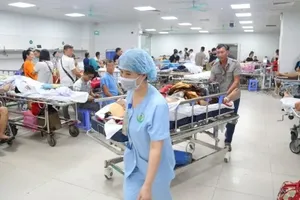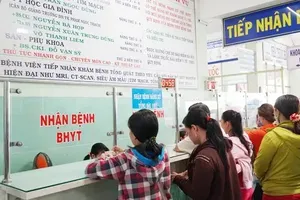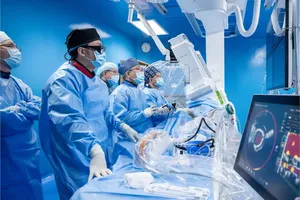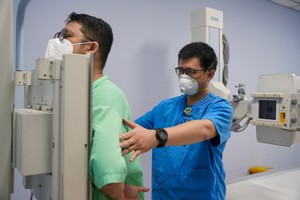
Extremely slim chance of survival
“Our family were already preparing for My Anh’s funeral. No one, absolutely no one, believed she could survive after a 20-ton truck ran over her...” Pham Van Tai from Binh Tan Ward (HCMC), My Anh’s father, chokes up, recalling the horror that unfolded in late February 2024.
At that time, 18-year-old Pham Thi My Anh was brought to the hospital in a state that was, frankly, beyond hopeless. She had catastrophic injuries: respiratory failure, severe lung contusion, a lacerated liver, a ruptured kidney, traumatic brain injury, and massive wide-scale subcutaneous degloving. Her school PE uniform was soaked in blood.
“All of her injuries pointed to a critical state. The prognosis was, by all measures, unsurvivable. We didn’t dare hope for anything,” explained Level-II Specialist Nguyen Do Nhan of Thong Nhat Hospital’s Cardiovascular and Thoracic Surgery Department after analyzing the girl’s status. “She could have died right on the spot from traumatic shock, or from shock due to blood loss, or from her lungs being so severely crushed.”
The moment she was wheeled in, the Emergency Department hit the button for an internal Code Red. This order scrambles all specialists immediately; all red tape is simply vaporized. It’s a “war for life.”
Amidst the chaos, the team held an on-the-spot consultation, laser-focused on her vitals. My Anh had reportedly lost almost 4 liters of blood from a shattered pelvis. For two days, the team fought, but she kept falling back into shock. As her parents wrestled with the pain, doctors waged a tug-of-war in the ICU, driven by the mindset “Never give up”.
Then, at midnight on the third day, her father, Mr. Tai, was called in. Panicked, he ran in, but then saw his daughter’s eyes fluttered open. She sensed him. “Try to lie still, the doctors will cure you!” he managed, tamping down his own emotions to soothe his daughter, and maybe himself as well.
From that flicker of hope, the team controlled the bleeding and stabilized her lungs. Her youth was a significant advantage, speeding recovery. The next threat was a massive area of degloved skin with high infection risk. Instead of complex grafts, doctors meticulously used drains, compression bandages, and nutrition, managing to save her entire original skin.
Thanks to the hospital’s multidisciplinary strength, doctors coordinated, anticipating and heading off complications. After two months of this relentless battle, she reunited with her family, intact and able to move slowly on her own.
According to Level-II Specialist Nguyen Do Nhan, luck was certainly part of the miracle. But the most important factors, he stressed, were speed and coordination. “If that emergency response had been delayed by just a few minutes,” he stated, “she would have been lost at that first gate of death.”
The Code Red, it turns out, is a really effective process that “slashes red tape”, from paperwork to personnel. When it’s called, representatives from every required department must be in the ER immediately to assess and treat on the spot, racing against time. My Anh, like so many other critical cases, was saved in part thanks to the efficiency of the Code Red protocol and that inter-departmental synergy.
The internal Code Red protocol was pioneered by Assoc Prof Dr Tang Chi Thuong at HCMC’s Children’s Hospital 1 back in 2010, when he was the hospital’s director. Following its success, the HCMC health sector developed the “Inter-Hospital Code Red” to connect multiple hospitals and mobilize resources. In 2016, the Ministry of Health added the Code Red protocol to the national hospital quality criteria. In its first five years in HCMC, it reportedly saved nearly 3,700 critical patients.
Time is life
On that fragile line between life and death, time is life. To beat death, there is a need for a whole system to race in unison. In these races, the synergy of multiple departments is non-negotiable, and this is the special advantage of top-tier, multidisciplinary hospitals.
A few months ago, a head-on collision with a container truck left 24-year-old Nguyen Thi Huyen with near-total-body deformation. Transferred to Military Hospital 175, Huyen was in an extremely critical condition: crushed lungs, ruptured bladder and ovary, a shattered pelvis, and massive, uncontrolled abdominal bleeding.
Instantly, the entire hospital went on Code Red, scrambling experts for an all-night surgery, a race against death as the patient could have died at any stage. She had a wind-swept pelvic fracture as well as a rare and complex injury. Doctor Tran Quang Khanh described it as one side blown open and the other smashed shut, like “wind has blown the entire frame askew.”
In the first critical surgery, doctors applied an external fixator, repaired her bladder and ovary, and halted the multi-trauma shock. But this was only halfway. Two weeks later, she returned for pelvic reconstruction, aided by 3D-printing support to simulate the injury and pinpoint optimal placement. After three exhausting months, the young woman had beaten the odds and could sit up. The doctors’ dedication has “given her back her future.”
In 2023, Cho Ray Hospital achieved its own miracle, saving a traffic accident victim whose lower half was crushed by a container truck. The victim had nearly no chance of survival.
Doctors reportedly skipped multiple steps like tests and imaging, rushing the patient to the OR in 30 minutes. The team had to use an artificial mesh just to keep his organs from spilling out, as his left pelvic bone was gone.
After 11 surgeries, 112 days of treatment, and his own fierce belief in life, the patient miraculously defied his fate. It was a miracle of medicine, and of a belief in life.
























